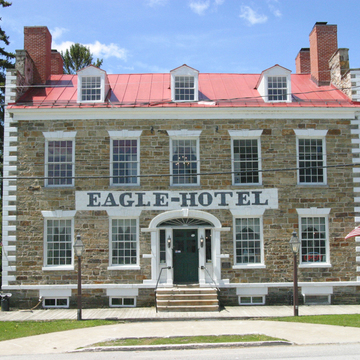This building is the heart of the small village it dominates. Of locally quarried sandstone arranged in a two-story Georgian style, the hotel still serves as a gathering place more than 180 years after it was built as an office and inn for the stagecoach line from Pittsburgh to Waterford. The Works Progress Administration guidebook Erie: a Guide to the City and County (1938) notes that it “bears the rugged stamp of the frontier.” Nevertheless, stagecoach stops were in general a step above the inns that housed drovers and rivermen, catering to a more sophisticated clientele. Here, builder Thomas King used dramatic bridged chimneys on the side elevations, twelve-over-twelve windows topped with stone lintels with keystones, and corner quoins to contrast with the irregularly coursed sandstone walls. He carved his name in the datestone at the north gable end. The open-winged carved eagle that stood above the elliptical fanlight has been removed from the entrance, but otherwise, the elegant doorway is intact. Since 1977, the building has been owned by the local historical society and houses a functioning restaurant and shop. In 1841, one of carpenter Amos Judson's nephews who married Thomas King's daughter used the form of this building for a brick house at 104 Walnut Street.
You are here
Eagle Hotel
If SAH Archipedia has been useful to you, please consider supporting it.
SAH Archipedia tells the story of the United States through its buildings, landscapes, and cities. This freely available resource empowers the public with authoritative knowledge that deepens their understanding and appreciation of the built environment. But the Society of Architectural Historians, which created SAH Archipedia with University of Virginia Press, needs your support to maintain the high-caliber research, writing, photography, cartography, editing, design, and programming that make SAH Archipedia a trusted online resource available to all who value the history of place, heritage tourism, and learning.


